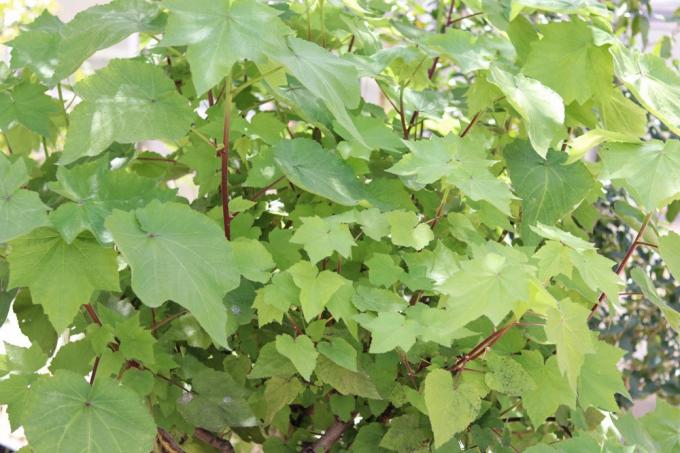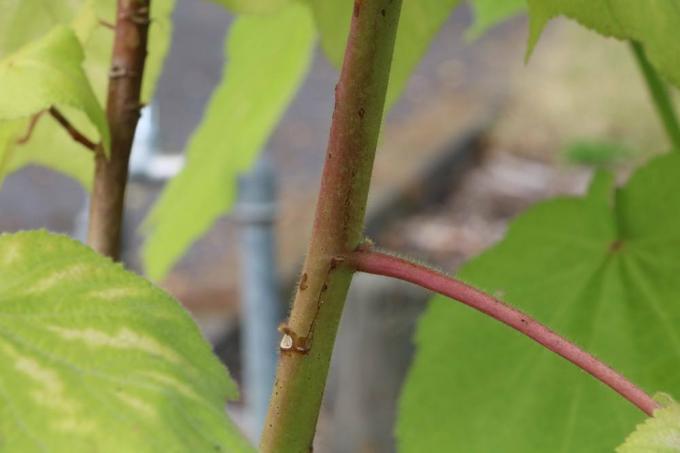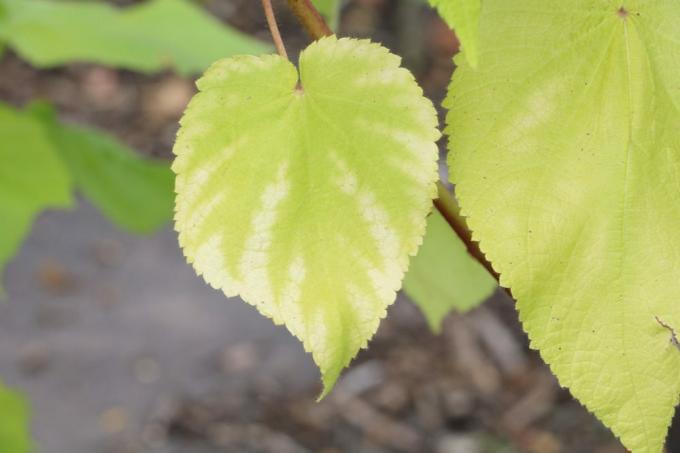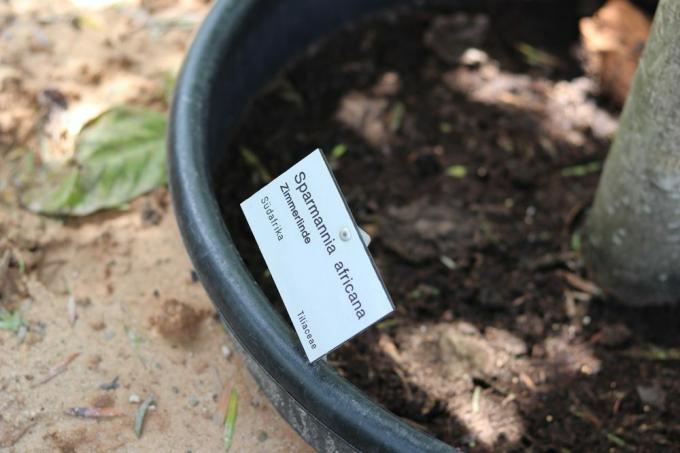
table of contents
- Characteristics
- origin
- Is the linden tree poisonous?
- growth
- Leaves, flowers and fruits
- Location
- Substrate
- Planting and repotting
- to water
- Fertilize
- Cut
- Multiply
- Diseases
- Pests
- Overwinter
Profile and care information open +conclude -
- Flower color
- White
- Location
- Negative
- Heyday
- January, February, March, April, May, November, December
- Growth habit
- upright, bushy
- height
- up to 3 m high
- Soil type
- sandy, loamy
- Soil moisture
- moderately moist
- PH value
- neutral
- Limescale tolerance
- Calcium tolerant
- humus
- rich in humus
- Poisonous
- Yes
- Plant families
- Mallow family, Malvaceae
- Plant species
- Container plants, potted plants, house plants
- Garden style
- Pot garden, winter garden
The name Zimmerlinde is deceptive. What, with its light green, heart-shaped, hairy and almost translucent leaves, makes us feel at home Linden tree is actually an African tree. Indoors, its growth remains modest, but can still reach the ceiling. This linden tree improves the room climate and, according to Far Eastern Feng Shui, also the flow of energy. If it is well cared for in this country, this immigrant sapling even contributes a few enchanting flowers.
Characteristics
- Botanical name: Spar (r) mannia africana
- Alternate name
- Plant family: Mallow family (Malvaceae)
- Growth habit: bushy
- Height: up to approx. 3 m
- Leaf shape: heart-shaped
- Leaf color: light green
- Flower shape: umbels
- Flower color: white
- Location: off-sun
- Soil type: sandy to loamy
- Soil moisture: moderately moist
- Lime tolerance: lime tolerant
- Nutritional requirements: high
- Garden style: pot garden, winter garden
- Ornamental value: decoration of leaves and flowers
- Use: container plant, houseplant
- Toxicity: weak
origin
The Sparmannia is mainly native to South Africa, occasionally it also thrives in South America. In the 18th In the 19th century it came to Europe, where it was quickly given the name `` Zimmerlinde '' due to its leaf resemblance to the linden tree. Because of its geographical origin, it is often referred to as the Cape Linden tree. Consistent outdoor cultivation is not possible in this country for climatic reasons. But it has now established itself well as a houseplant and is even one of the most popular green plants in your own four walls.
Is the linden tree poisonous?

Many houseplants are beautiful on the outside and poisonous on the inside. Especially when curious children live in the house or pets who can move around freely in it, clarifying the toxicity can be a life-saving action.
The all-clear can be given to the room linden tree in this regard. It is not highly toxic and therefore not life-threatening either. However, their leaves can cause skin irritation in some sensitive people. Of course only if there is direct contact. For this reason, it is also known as slightly poisonous.
As a precaution, gloves should be worn during care that requires close contact. It is still unclear whether the skin irritation is caused by toxic substances or by mechanical effects on the hair.
growth
The Sparmannia africana grows shrubby or tree-like. While its initially green shoots become more and more lignified over time, it sheds part of its leaves. In the wild, the Sparmannia africana develops into a magnificent tree, the top branches of which reach seven meters in height.
As a room linden tree, its growth is limited to about three meters, which is not least due to the constant use of the scissors. These cutting measures keep it at a size that is suitable for a room, otherwise it would literally go through the roof. If you have a high winter garden, you can give it more freedom in it and see whether it can reach African heights in it.
Leaves, flowers and fruits

Its lime green leaves are its permanent ornament, while the flowers appear from November to around May of the following year. However, in order for the Sparmannia to bloom, it must not be cut in the spring.
- the leaves are toothed heart-shaped, but with "corners and edges"
- they are light green and finely haired
- become up to 20 cm long and wide
- Flower buds hang from long umbels
- the white flowers straighten up later
- the particularly numerous stamens are striking
- they protrude strongly from the flower
- they are colored yellow-red and arranged in a tuft
The Sparmannia africana is pollinated by insects, then it develops capsule-shaped fruits. But these animal pollinators are unlikely to be found indoors, so we usually have to do without this jewelry.
Tip: If you keep your ambient temperature evenly cool, your room linden tree can bloom all year round.
Location
If a plant is naturally intended for an open space, an enclosed space can only be a modest substitute for it. So that the linden tree does not have to do without essentials, it should meet its needs as best as possible. If the space offered deviates very much from the ideal, it will not be tolerated by the Sparmannia and it shows this clearly through its deteriorated appearance. These are your requirements in detail:
- needs a lot of light
- must not hide behind curtains or in a dark corner
- however, it reacts sensitively to solar radiation
- quickly burns the leaves
- Avoid direct midday sun at all costs
- Morning and evening sun are allowed
- East and west windows are ideal
- a change of location outside is possible in summer
- but it must be protected from the wind
- she enjoys temperatures between 5 and 15 degrees Celsius
- a little cooler in winter
- needs high humidity
- large bathroom with light window offers the best room climate
Tip: If you cannot provide the linden tree with a sufficiently moist location, use the spray bottle regularly to compensate for this and wet its leaves with a fine mist of water.
Substrate

The room linden tree demands a lot of nutrients which, as a house plant, it can only get from a very limited amount of soil. It is all the more important that the contents of the pot are well chosen.
- nutrient-rich soil
- Potting soil mixed with compost
- the soil should also be well loosened
- Hydroponics is also suitable for the linden tree
- instead of earth, their roots are covered with expanded clay
Tip: Whenever possible, move your Sparmannia africana into a hydropot. She has an enormous water requirement, which can be optimally met and regulated by this type of attitude.
Planting and repotting
A room linden tree usually moves in with us already planted, because in specialist shops this house plant can only be found in a pot. However, your owner must regularly replace this dwelling as soon as the growing linden tree fills it with its roots and needs more space for further growth. Even just an exchange of the earth may be appropriate from time to time.
- the ideal bucket should be sufficiently large and, above all, stable
- the plant can grow very large and needs a secure hold
- it should also have some drainage holes
- excess water must be able to drain away
- It is best to repot the linden tree in spring
- never in the winter blooming season
Repotting takes place in a few steps, which are described in more detail below. When repotting a particularly large linden tree, two additional hands could be helpful.
- Carefully remove the sparmannia from the current pot.
- Carefully inspect their roots for signs of rot or damage. Leave only the healthy and flawless roots on the plant. Cut off any other roots with clean, sharp scissors.
- Place the linden tree in the new container, which should be a little larger than the old one. Under no circumstances should the new pot be oversized.
- Fill the spaces with new substrate and press it down lightly.
- Water the linden tree well.
Tip: Be prepared that a well-growing Sparmannia africana might even call for a larger home several times a year. For old linden trees, on the other hand, it is enough if they are repotted every two years.
to water

The Sparmannia africana makes the biggest leap in growth in the period from March to September. Then their thirst for water is particularly high and good care requires regular watering.
- Water regularly during the growing season
- only use water at room temperature
- Let the bale dry in between
- there must also be no waterlogging
- after September the need for water decreases
- the water consumption also depends on the room temperature
- the cooler the pot is, the less the watering can has to visit it
- this is especially true for the winter quarters
The irrigation system of a hydroponics makes maintenance a lot more convenient, as only the water supply has to be refilled at longer intervals. Here you can rely on the "call" of the water level indicator.
Fertilize
Fertilizing is a major part of grooming. The high nutrient requirements of the linden tree must be covered with a liquid fertilizer from spring to autumn. This is administered every two weeks via the irrigation water. The nutrient depot can also be replenished in the long term by mixing in horn shavings.
From October onwards there is no fertilization at all, at most sporadic and low-dose fertilization is conceivable during this time.
Cut

The linden tree has the genes of a tree that naturally strives with its branches on all sides and aims high with the crown. He does not have this unlimited freedom in a limited space. This fact doesn't cause any problems with young plants, but it becomes a real challenge over the years. The solution comes with sharp blades and is called secateurs. That is the only reason why she is allowed to touch the tree. Of his own accord, he does not ask for such care. The owner of the linden tree alone decides when and how to cut. There are two possible ways of doing this.
The first possibility is:
- the tree is allowed to grow freely at first
- until it completely fills the available space
- then cut back radically
- all shoots are shortened by about half
As soon as, after months or years, he has recaptured the space that has become free, the radical cut is repeated.
The second possibility is:
- is not as radical as the first method
- this has to be cut more often
- individual disturbing instincts are removed again and again
- the size of the plant is continually limited
With this cut, the shape of the linden tree is largely retained, as the correction cuts are usually minimal.
Multiply
Increasing the linden tree is possible without any problems. There are several ways to do this.
Propagate via cuttings
Strong head cuttings are the beginning of large trees that you can grow yourself from the existing linden tree. Since old linden trees are lazy in flowering, you can ensure fresh supplies. Under good conditions, the young linden tree will even bloom in the first year.
- Start propagation in spring or summer at the latest
- Cut cuttings 15 cm long
- Shorten large leaves by two thirds
- Plant cuttings in a mixture of sand and peat
- Put the pots in the light
- Keep the soil moist throughout
- new shoots are a sign of rooting
- then it's time to repot
Tip: You can also let the cuttings root in a glass of water before planting them in soil.
Propagate by seeds
Perhaps you are lucky enough to have a few seed pods hanging from your linden tree. And maybe you are one of those people who are blessed with plenty of patience. Then you can exploit the potential of the seeds and elicit new linden trees from them. In order for your attempts to be crowned with success, you should carry out the propagation carefully according to the following instructions:
- Soak the seeds of the Sparmannia africana in lukewarm water for six hours to swell.
- Fill a bowl with soil and spread the seeds on it.
- Sprinkle some sand over it.
- Cover the bowl with foil and find a bright and warm place for it with temperatures around 25 degrees Celsius.
- Keep the soil moist throughout.
- After about two weeks, the seeds will germinate. Wait until the seedlings are approx. 5 cm tall. Then give each seedling its own pot.
Tip: If your linden tree has not given you a seed pod, you don't have to sadly give up propagating it. Although the seeds of the room linden tree are not free in stores, they are always available.
Diseases
The linden tree is a healthy plant that seldom sucks in the house. If it looks somehow sick or unattractive, it usually owes it to its owner. He either gave her the wrong location or cared for her incorrectly. As soon as the causes are found and eliminated, there will soon be an improvement. These are the most common care mistakes and their consequences:
- Linden tree receives little light: leaves become small or turn brown, shoots are limp and weak, extra-long shoots can also form or they do not bloom
- the roots are wet: mold forms
- a sunny place: leaves get burn marks
- insufficient nutrients: leaves turn yellow
If a lot of leaves fall outside of winter, it could be due to a combination of several care mistakes: little or too cold water, a dark or too warm location and drafts.
Pests

A linden tree that is allowed to take a trip to the garden in the summer months can occasionally be attacked by the pests that act there. Aphids and scale insects especially like the juice of this African beauty. Since the tiny ones are not immediately recognizable at first glance, you should take your plant Regularly examine it and if necessary promptly and for the sake of the environment biologically against it proceed.
Whiteflies can be kept away with yellow boards. However, if they have already settled down, they must be fought specifically. First, gentle home remedies such as soapy water should be given a chance before special pesticides are used.
The most important check-up is due as soon as the plant moves back into the house. If it brings these pests in unhindered, your other houseplants could soon also fall victim to them.
Overwinter
There is no need to worry that a linden tree sheds its leaves in autumn. She would like to take a break and spend it cooler if possible.
- It is too warm in the living rooms, a winter quarter is needed
- 6 degrees Celsius is ideal
- high humidity must still be
- Spray regularly with lukewarm water
- pour only modestly
- do not fertilize
- or only sporadically and economically when there are still leaves on
- check for pests
A large linden tree can easily damage room doors or furniture when moving to winter quarters and be damaged in the process. Especially the young shoots that are not yet woody are delicate and fragile. You should therefore be careful and, if necessary, allow yourself to be Conducted by another person who has a better overview from a distance.

